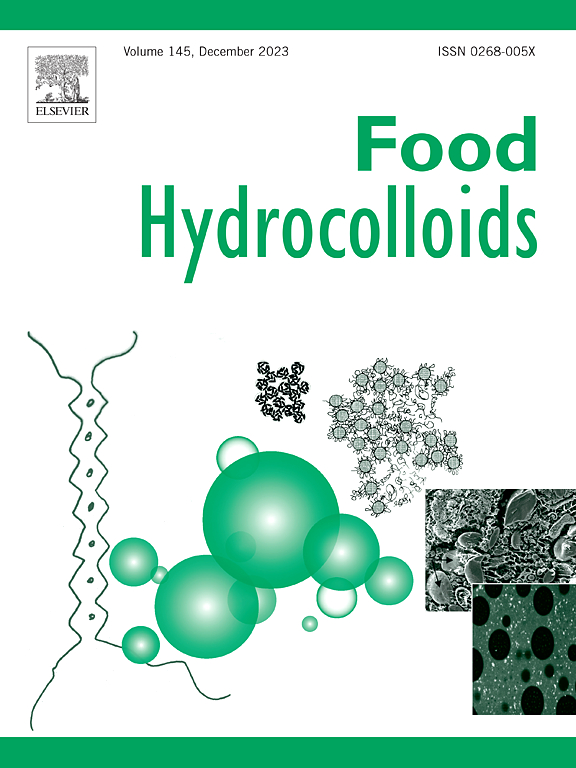Potential enhancement of thermal stability in soy protein nanofibrils by metal ions
IF 11
1区 农林科学
Q1 CHEMISTRY, APPLIED
引用次数: 0
Abstract
Fibrillation, a universal property of proteins, serves as an effective strategy to enhance the functional properties of food-derived proteins. However, certain protein fibrils are susceptible to degradation at elevated temperatures, which limits their application. This study investigates the thermal destabilization behavior of soy protein nanofibril (SPNF) during prolonged heating (85 °C, 0–72 h) and explores the role of Na+ and Ca2+ in enhancing fibril thermal stability. The aggregation, morphology, and structural properties of the fibril systems were analyzed, revealing that all fibril systems developed weak gels after 24 h of incubation. SPNF and Na+-induced SPNF experienced gel network disruption and aggregation during prolonged heating, leading to increased particle size, turbidity, and reduced storage modulus, transitioning to fluid state at 36 h. Meanwhile, both exhibited a rapid decrease in ThT fluorescence and a transition from linear fibrils to particulate aggregates within 60 h. CD and FTIR indicated that as fibrils degraded, the β-sheet structure converted to β-turns, with a significant reduction in hydrogen bonding. Conversely, SPNF induced by 100 and 33 mM Ca2+ effectively resisted aggregation, maintaining gelation at 60 and 48 h, respectively. The ThT fluorescence, β-sheet structure, and hydrogen bonding decreased relatively slowly with prolonged heating, and the fibril morphology remained intact at 60 h. Thermogravimetric analysis confirmed that 100 mM Ca2+-induced fibrils had a higher thermal degradation temperature (341 °C). These findings suggest that Ca2+ enhances SPNF thermal stability, providing a theoretical basis for its application in high-temperature environments in food processing.

金属离子对大豆蛋白纳米纤维热稳定性的潜在增强作用
纤维性颤动是蛋白质的普遍特性,是增强食物源性蛋白质功能特性的有效策略。然而,某些蛋白质原纤维在高温下容易降解,这限制了它们的应用。本研究研究了大豆蛋白纳米纤维(SPNF)在长时间加热(85°C, 0-72 h)过程中的热失稳行为,并探讨了Na+和Ca2+在增强纤维热稳定性中的作用。分析了原纤维体系的聚集、形态和结构特性,发现所有的原纤维体系在孵育24小时后都形成了弱凝胶。SPNF和Na+诱导的SPNF在长时间加热过程中发生凝胶网络破坏和聚集,导致颗粒尺寸增大,浊度增加,存储模量降低,在36 h时转变为流体状态。同时,两种SPNF在60 h内都表现出ThT荧光快速下降,从线性原纤维转变为颗粒聚集体。CD和FTIR表明,随着原纤维降解,β-片结构转变为β-转变,氢键明显减少。相反,100和33 mM Ca2+诱导的SPNF有效地抵抗聚集,分别在60和48 h保持凝胶。随着加热时间的延长,ThT荧光、β-片结构和氢键的下降相对缓慢,60 h时原纤维形态保持完整。热重分析证实,100 mM Ca2+诱导的原纤维具有更高的热降解温度(341℃)。这些结果表明,Ca2+增强了SPNF的热稳定性,为SPNF在食品加工高温环境中的应用提供了理论基础。
本文章由计算机程序翻译,如有差异,请以英文原文为准。
求助全文
约1分钟内获得全文
求助全文
来源期刊

Food Hydrocolloids
工程技术-食品科技
CiteScore
19.90
自引率
14.00%
发文量
871
审稿时长
37 days
期刊介绍:
Food Hydrocolloids publishes original and innovative research focused on the characterization, functional properties, and applications of hydrocolloid materials used in food products. These hydrocolloids, defined as polysaccharides and proteins of commercial importance, are added to control aspects such as texture, stability, rheology, and sensory properties. The research's primary emphasis should be on the hydrocolloids themselves, with thorough descriptions of their source, nature, and physicochemical characteristics. Manuscripts are expected to clearly outline specific aims and objectives, include a fundamental discussion of research findings at the molecular level, and address the significance of the results. Studies on hydrocolloids in complex formulations should concentrate on their overall properties and mechanisms of action, while simple formulation development studies may not be considered for publication.
The main areas of interest are:
-Chemical and physicochemical characterisation
Thermal properties including glass transitions and conformational changes-
Rheological properties including viscosity, viscoelastic properties and gelation behaviour-
The influence on organoleptic properties-
Interfacial properties including stabilisation of dispersions, emulsions and foams-
Film forming properties with application to edible films and active packaging-
Encapsulation and controlled release of active compounds-
The influence on health including their role as dietary fibre-
Manipulation of hydrocolloid structure and functionality through chemical, biochemical and physical processes-
New hydrocolloids and hydrocolloid sources of commercial potential.
The Journal also publishes Review articles that provide an overview of the latest developments in topics of specific interest to researchers in this field of activity.
 求助内容:
求助内容: 应助结果提醒方式:
应助结果提醒方式:


